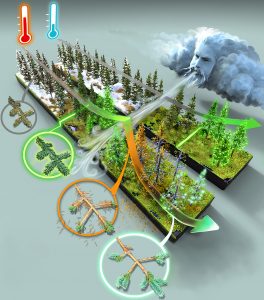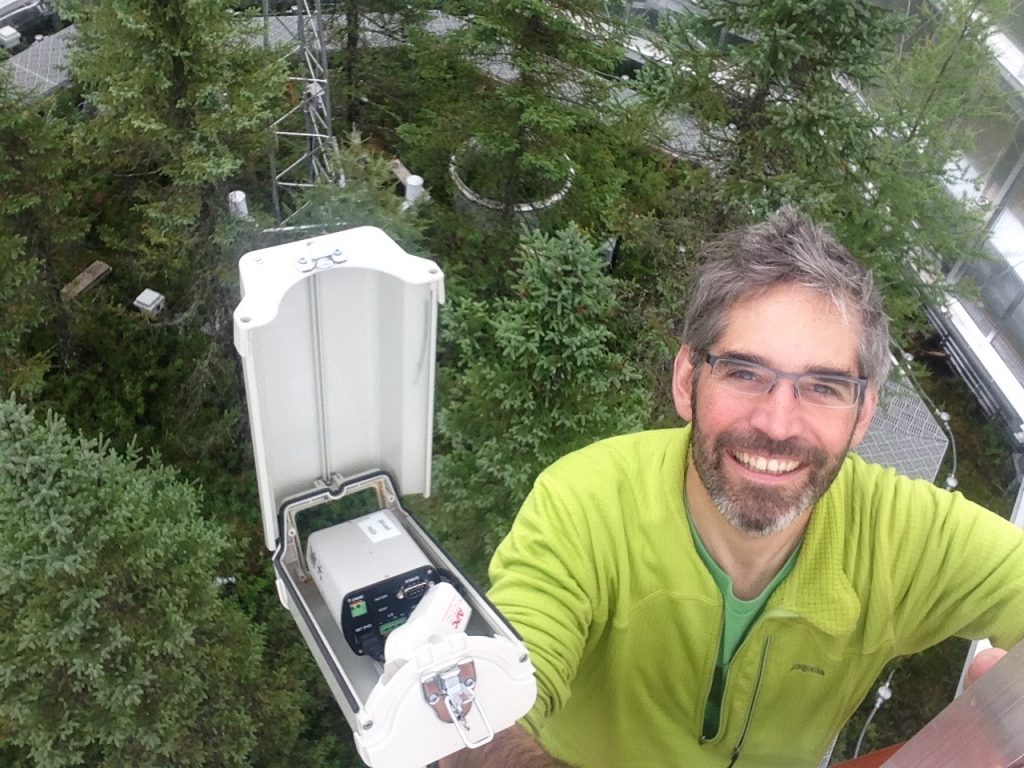New findings published in the journal Nature by Northern Arizona University researcher Andrew Richardson offer some of the first experiment-based evidence that a warmer world will significantly shift ecosystem-wide growing seasons, putting plants at higher risk during extreme temperature swings.
Richardson and a team of collaborators conducted a unique experiment in boreal forests showing that warmer temperatures triggered earlier springs and delayed the onset of fall—lengthening the growing season by three weeks or more. Surprisingly, the longer growing season increased the vegetation’s vulnerability to frost events.
“As the climate changes, the overall frequency of freezing temperatures will decrease,” said Richardson, a professor in NAU’s Center for Ecosystem Science and Society and School of Informatics, Computing, and Cyber Systems. “But what we found was that warming also caused some plants to green up too early, making them more vulnerable to frost damage.”
Whole-ecosystem approach makes the SPRUCE experiment unique
Using digital repeat photography—in which conventional digital cameras are programmed to take multiple images of a specific frame each day—researchers measured green-up and green-down. Simulating five levels of warming in different chambers, ranging from zero to 16.2 degrees F (zero to 9 degrees C) above ambient temperature, scientists used both photographic data and direct observation to track responses in each plant species. This whole-ecosystem approach makes the SPRUCE experiment unique.
“No previous studies have treated intact communities of tall, mature vegetation—like these forests—to both elevated temperatures and elevated CO2 levels,” Richardson said. “This study is totally different in its approach.”
The results of the experiment, collected over two years, were striking. Richardson’s team found that warmer temperatures accelerated all phenological phases associated with spring—including leaf-out, flowering and seed development—moving up these changes by about six days for every one degree F (three days per one degree C). Warmer temperatures also delayed the onset of autumnal stages, such as coloration and leaf-drop.
“We didn’t expect to see as much of a response in fall as we did, since those changes have often been considered to be controlled by day length,” Richardson said. “So seeing changes at both the start and end of the growing season was surprising.”

Dramatic weather changes provide a window into freeze response
In spring 2016, dramatic spring weather changes provided the SPRUCE team an unexpected window into freeze response. An unusually warm March was followed by an extreme cold snap in April (ambient temperatures dropped to 5 degrees F, or -15 degrees C). Trees in the warmest chambers suffered tissue damage, while trees in chambers with less warming incurred minimal tissue damage from the freeze.
“It was interesting that only the trees in the warmest chambers suffered frost damage, even though trees in the other chambers experienced much colder temperatures,” Richardson said. “When it comes to tolerating below-freezing temperatures, how warm it gets early on matters more than how cold it gets again. And as global temperatures rise, that has big implications for forest health and ecosystem productivity.
“The idea that vegetation might be more susceptible to frost damage with climate change is kind of counter-intuitive, but this is the first experimental support for that idea,” Richardson said.
The extended growing season the researchers documented also has far-ranging implications for a changing climate. An earlier spring and more frost-vulnerable plants could tax water resources and alter carbon uptake capacity. Flowers that rely on birds and insects to reproduce may struggle if they bloom earlier and their pollinators don’t make a symmetrical shift.
The study in Nature also challenges the prevailing idea that day length, or photoperiod, acts as a hard limit on phenological events. Day length did not check the forests’ responses to rising temperatures. And if, as these early SPRUCE findings suggest, photoperiod has a limited role in preserving vegetation’s historical phenological cycles, then an upper limit on warming’s effect on ecosystems may not kick in for a long time.
“We observed a photoperiod effect in comparatively few cases, and then only in the warmest chambers,” Richardson said. “So given current projections of temperature changes through the end of the 21st century, we can expect to see the growing season continue to extend, unchecked by photoperiod.”
The cameras Richardson used to monitor the chambered forests at SPRUCE are part of PhenoCam, a vast network of automated digital cameras, observing seasonal and long-term changes in diverse ecosystems across North America, from the tundra to the tropics.
Kate Petersen, Center for Ecosystem Science and Society
(928) 523-2982 | kate.petersen@nau.edu
Kerry Bennett, Office of the Vice President for Research
(928) 523-5556 | kerry.bennett@nau.edu




